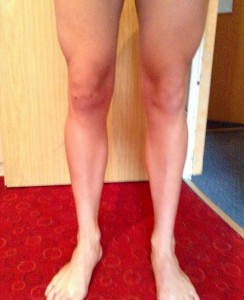
Day 12 Post Surgery
I have a history of knee issues and about a year and a half ago underwent a small surgery to clean out the joint. After a lot of hard work and testing, I am now basically pain free. I had to eliminate and modify exercises and implement a lot of different strategies to get here. I think everyone can take control of their own pain, and there is always a solution, or at least some relief. If you have sore and angry knees, there are many ways you can help yourself.
1. Don’t Push Through Pain
Listen to your body.
If an exercise hurts your knees, then it’s bad. Pushing through pain in your joints is never a good idea, and your knees are no exception.
There is always a way to modify an exercise so that it doesn’t hurt you, or find a suitable alternative. The rest of these tips will give you lot’s of ideas on how to do that, but the most important thing for you to remember is to not to push through pain.
No one exercise is good for everyone. For example, I’ve often been told to do leg extensions to build strength around my knee, but every time I get on that machine I end up in pain. Some other people with similar issues to mine swear by it, but it hurts and aggravates me.
If something hurts, then you should probably stop.
2. Get Stronger Glutes
Strong glutes can take a whole lot of pressure off your knees. Many people with knee pain have a bum that is either switched off or weak. Luckily it is a really easy place to work on.
The important thing is to start from the bottom and work up. Basic glute exercises that target only those muscles are a really good place to start. There is no point to get working on complex exercises when you can’t get your glutes involved. Exercises like birddogs, glute lifts and bridges are a great place to start. You should do them early in your program so you don’t skip out on them and get your glutes activated for the rest of the workout.
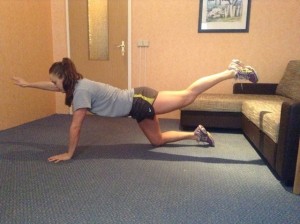
Bird Dog
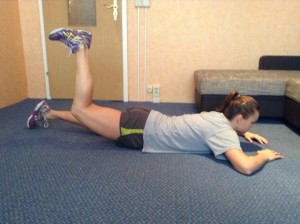
Glute Lift

Bridges
Once you have activated and got a bit more strength in your glutes, you can move onto more complex exercises. However, instead of doing quad dominating work, you should try to exchange them for some more hip dominate quad work, and do some heavy glute work.
For example:
- Sit back on your squats a little more, don’t go as deep.
- Start doing step ups with a vertical shin and engage those glutes.
- Do some good old fashioned dead lifts.
- Grab a barbell and do some heavy hip thrusts.
3. Ditch The Lunges
For people with sore and angry knees, lunges can really suck. They are a very popular exercise and often prescribed to get stronger legs, but for some they are going to cause pain.
When you step forward and plant your foot on the floor you often create a big shearing force through the knee. Shearing forces are unaligned forces pushing one part of a body in one direction, and another part of the body in the opposite direction (wikipedia). If you are getting irritated and sore after lunges, this is probably why and you need to stop.
There are many other variations you can do that won’t create any shear force in your knee and will help you build muscle safely. Specifically keeping a vertical shin (see point 6). Exercises like Bulgarian split squats and step ups create a similar stimulus on the quads, but we are keeping our foot in place, our shin vertical and eliminating all shearing forces on the knee.
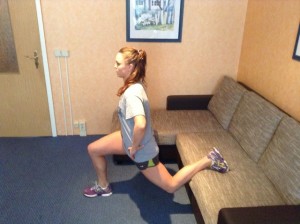
Split Squat
4. Stop Jogging
Jogging sucks for sore knees. Which is why I dislike it so much.
The amount of force that is ripping through your knee over a 20 minute run is more than aggravated knees can handle. As you pound the pavement (literally), you are getting shear through the knee and in general just putting a lot of force
If you get sore knees from jogging, you have other options. If you want to do cardio work and are in the gym, jump on the bike, the elliptical or the rowing machine. If you like to get in the water swimming is great cardio.
Check out this article for some intervals you can do on the bike.
5. Run Backwards
When athletes hurt their knee, have a surgery or are doing some form of rehabilitation you will often see them running backwards. They start slowly and build up pace and distance, but they start with backwards running before turning around and sprinting.
Why do you find them running around a track backwards? Because there is much much less shear on the knee. This happens to your knee when you put your foot on the floor when sprinting forwards.
If sprinting aggravates your knee and you want to get some high intensity conditioning in, do some backwards sprints.
Start slow and build up your stamina, don’t go full pace right away. The best place to do it on is an athletics track where you have a decent amount of space and don’t keep having to look over your shoulder.
A good protocol is something like 10*50m backwards runs on a track or field. You can build up speed after a few sessions.
6. Watch Your Angles During Quad Work
We have spoken a lot about shear force on the knee in this article. Reducing it means taking a lot of pressure off the knee. When you are working in the gym or at home, you should focus on exercises that reduce shear force. Keeping your shin vertical, and stopping your knee moving over your foot during exercises is a way to reduce the shear. Not only that it will engage your glutes more.
It’s important to stop trying to target your quads with exercises than shift your weight forward. Try to sit back more often and get your hips involved.
Two great exercises you can implement at home or in the gym are the bulgarian split squats and step ups.
Check out this article on how to do step ups.
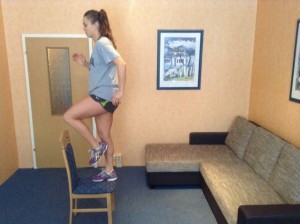
7. Smash Your Quads In Your Cooldown
Actually, it doesn’t really matter when you do this, but a great time is during your cool down.
You have worked your muscles hard and your rec fem (long quad muscle attaching to the hip and knee) can get tired and tight. This is one of the most problematic muscles when it comes to knee pain. When your rec fem gets tight and aggravated, it places a lot of pressure on the front of your knee. Plus, trigger points in the area can refer down into the knee.
It is pretty simple to release, but if it is tight and you have never had work on it before, beware… it’s going to hurt. Check out this article with a video on how to release this muscle.
8. Check Your Chains
It is important to check up and down the chain when you have knee pain. This means taking a good look at your ankle strength and mobility, as well as your hip strength and mobility. When either one of these is misfiring or inadequate, you are forcing the knee to do extra work.
For example, if you lack motion at the ankle, when you squat you will have to bend your knee more which will increase the shear force going through it. Similarly, if your hips are tight or weak, you will not use them during every day movements such as walking and will compensate through your knees.
Take a look at these two articles about ankle and hip mobility.
Bottom line: Be smart about your training, you can still work really hard and take care of your knees at the same time.